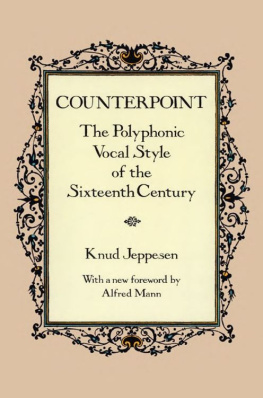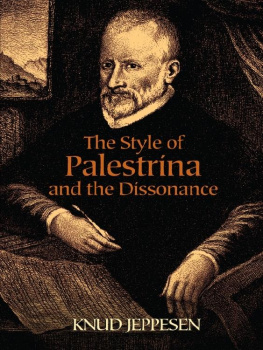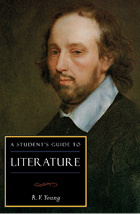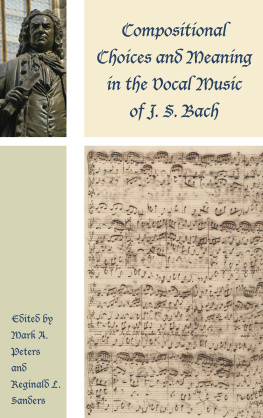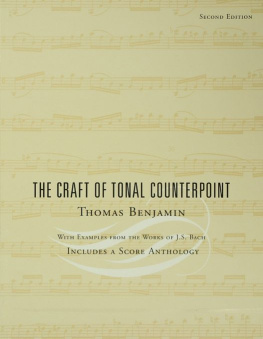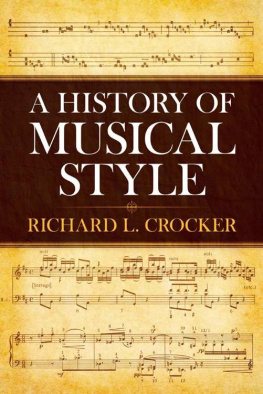COUNTERPOINT
THE POLYPHONIC VOCAL STYLE
OF THE SIXTEENTH CENTURY
KNUD JEPPESEN
Translated by Glen Haydon
With a new foreword by Alfred Mann
DOVER PUBLICATIONS, INC.
NEW YORK
IN GRATEFUL MEMORY OF
MY DISTINGUISHED TEACHER AND FRIEND
CARL NIELSEN
Foreword copyright 1992 by Alfred Mann.
All rights reserved.
This Dover edition, first published in 1992, is an unabridged republication of the edition originally published by Prentice-Hall, Inc., New York, in 1939. (The original Danish edition was published by Wilhelm Hansen, Copenhagen, in 1931.) The foreword by Alfred Mann was specially written for the Dover edition. The errata of the original edition have been corrected directly in the text of the present edition.
Library of Congress Cataloging-in-Publication Data
Jeppesen, Knud, 18921974
[Kontrapunkt (vokalpolyfoni). English]
Counterpoint: the polyphonic vocal style of the sixteenth century / Knud Jeppesen ; translated by Glen Haydon ; with a new foreword by Alfred Mann.
p. cm.
Translation of: Kontrapunkt (vokalpolyfoni).
Translation originally published: New York : Prentice-Hall, 1939.
ISBN-13: 978-0-486-27036-4 (pbk.)
ISBN-10: 0-486-27036-X (pbk.)
1. Counterpoint. I. Title
MT55.J542 1992
782.221286dc20
91-40595
CIP
MN
Manufactured in the United States by Courier Corporation
27036X12
www.doverpublications.com
FOREWORD
C OUNTERPOINT, the title of Knud Jeppesens textbook, issued in its original Danish edition in 1931, suggests at once in its terse formulation the unusual quality of this work. It is a quality one is tempted to describe with a word that, well worn today, seems nevertheless particularly apt in this case: authenticity. Jeppesens Counterpoint stands apart from other manuals of the kind because the author considers its subject as a didactic phenomenon in its totality. He reviews its history in an opening chapter, and against this background he singles out the style of Palestrina as a pedagogical basis. But he does this with an authority unmatched by any of the authors who had taken a similar approach, because his textbook was preceded by a critical investigation of this style, a major scholarly achievement which was published under the title The Style of Palestrina and the Dissonance (original Danish edition 1923, English edition 1927). This monograph, in turn, was followed by more detailed studies, such as his essay dealing with a special aspect of the correlation between melodic and rhythmic accents as an idiomatic feature in Palestrinas music and its reflection in contrapuntal theory.
The study of counterpoint had existed for about a thousand years, although, as Jeppesen explains, the term itself was not used in the earliest contrapuntal treatises. It emerged about 1300, and it is fascinating to see the work of Johannes Tinctoris, the first great theorist in the modern sense (p. 8), arise in Jeppesens account against a background richly prepared. It is important, however, to realize that the word theorist itself is here not used in the modern sense because, unlike their latter-day confrres, the earlier authors of theoretical works were composers in their own right. Jeppesens Outline History of Contrapuntal Theory is especially valuable because it linksboth in his own writing and in that of the theorists he quotesthe names of the great masters, from Dufay to Bach, to the theoretical literature of their respective eras. In this survey he arrives at the significant point where contrapuntal theory was in the process of changing from a discipline concerned with describing a style as best it can to one which emphasizes pedagogical ends (p. 37).
The origin of this orientation is found in the generations of writers who raised the style of Palestrina to a didactic norm. It becomes clear from Jeppesens text that this came about by a gradual process which indeed required the perspective of time. The foremost theorist among Palestrinas contemporaries, Gioseffo Zarlino, was still guided, as Jeppesen explains, by the model of Josquin rather than that of Palestrina. Yet his formulations proved to be so cogent that they were paraphrased in theoretical works for more than a century. We see in these books a curious mixture of adherence to the old rules and awareness of continually changing styles. The first to break away from this pattern was Johann Joseph Fux, Master of the Imperial Chapel in Vienna and one of the most eminent composers of his time.
Fux so consciously adopts the Palestrina style that he declares himself the student of Palestrina in the dialogue form of his text. It is Fuxs historical as well as his pedagogical judgment that has rendered his book timeless. In very objective terms, Jeppesen states his own resulting indebtedness to Fux; in Jeppesens work the student finds the traditional study of counterpoint enhanced and clarified by the exploration of its sources.
An inherent problem of Jeppesens writing is its dualistic nature. Of necessity he speaks both as a historian and as a practitioner. The modern reader may be taken aback by the fact that, as early as in the Preface, Jeppesen quotes his own contrapuntal writing as a model, and that at the beginning of the actual instruction he adds the note, The cantus firmi numbers 1, 6, and 20 are by Fux; the others by the author (p. 107). A fine distinction may be observed here in that Fux referred in the choice of his cantus firmi expressly to chant. But Fux mixed melodies of Gregorian derivation with his own, and a key to this dichotomy is given in Jeppesens statement that the teacher or the pupil may, if he so chooses, compose for himself similar basic melodies (p. 107). He logically concludes that it is advisable to begin with the practice of writing pure one-voice melodies, since it cannot be too strongly emphasized that the linear idea dominates in counterpoint (p. xv).
Here, too, he offers important fresh advice, and thus he proves his role as a historian of wide vision even where he seems to depart from it. The student is forever obliged to realize that an ultimate standard cannot be established; the model remains an ideal for which to strive. It is amusing to read in the writing of the twentieth-century composer Ernest Bloch, himself a faithful disciple of Fuxs system, that among the innumerable cantus firmi he wrote for purposes of study are some that are almost as bad as the ones he found in the textbooks.
***
It was greatly to the credit of Glen Haydon, one of the outstanding figures among American musicologists of the past generation, that he recognized the unique stature of Jeppesens work and presented it in a first English edition. He did this with great sensitivity to the text of the editions published under the authors own supervision, and he added some valuable comments in the brief translators introduction. The Dover reprint of Haydons translation in unchanged form is therefore to be warmly welcomed.
Eastman School of Music
University of Rochester
August 1991
ALFRED MANN
Das Sprunggesetz des Palestrinastiis bei betonten Viertelnoten, in Report on the International Musicological Congress, Basel, 1925 (Leipzig: Breitkopf & Hrtel).
INTRODUCTION TO THE ENGLISH TRANSLATION
A S SUGGESTED by the title, Dr. Jeppesens Counterpoint is a textbook on the polyphonic vocal style of the sixteenth century. But it is no ordinary textbook, because it maintains an unusually happy balance between theoretical and practical problems, between historical and systematic methodology. It is a practical manual designed for classroom use in teaching modal counterpoint, the logical successor of the old strict or academic counterpoint and at the same time it affords invaluable material for the musicological seminar in which style-critical problems are under consideration. The present work is distinguished from the conventional treatise on counterpoint by its freedom from arbitrary rules and by its close adherence to a definite style period as a standard of reference. More and more, thoughtful musicians have come to realize that one cannot teach counterpoint in general without inviting endless controversy as to what is permissible and what is not. Hence a textbook based upon sound scholarly research in the music of a great period in the history of the art brings welcome relief to the serious but perplexed student and teacher of counterpoint.
Next page
